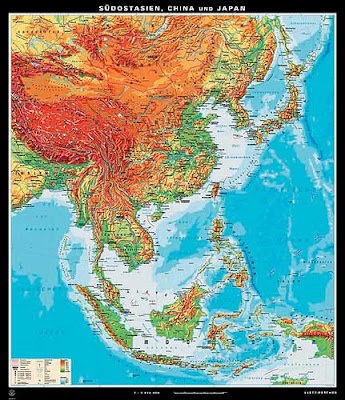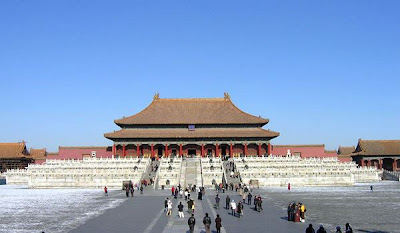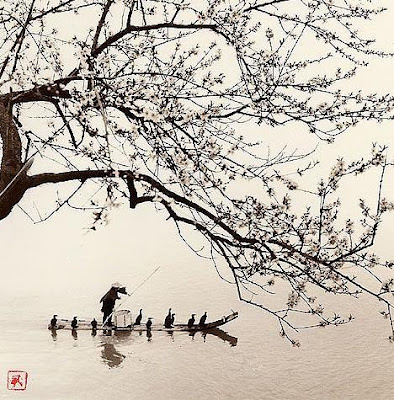Thank you Mr. Zoller!
The difference between school and life? In school, you're taught a lesson and then given a test. In life, you're given a test that teaches you a lesson.
Monday, November 21, 2011
Sunday, November 20, 2011
Saturday, November 19, 2011
Wednesday, November 16, 2011
The Yuan Dynasty
- Emperor
- Government by foreigners
- During this period the Mongolians were in control of China
- Because most mongolians could not read or write the entrusted government position to foreigners, specifically Muslims
- Ended Civil Service Exam
- They did not want to rely on chinese to run the government
- They did not believe that the Confucian learning was needed for government jobs
- During this time China was divided up into 4 classes
- The Mongols were on top
- Next came the foreigners from outside China
- The 3rd class was the Northern Chinese
- On the bottom was the Southern Chinese
- Eventually the chinese rebelled and reestablished their own government
The Song Dynasty
- Emperor
- Meritocracy
- It wad during this time the idea of the scholar-official reached it's height
- Civil service exam opened up to lower classes
- There were new state supported schools allowed lower clases to attend university
- Civil Service Exams
- The exams were set up to prevent cheating
- Only a small portion of people could pass the difficult exams
- They were based on the works of Neo-Confucianism
- This dynasty was eventually conquered by the Mongols
Confucius
Confucius, who's name translated literally means "Master Kong," was a very important Chinese teacher and philosopher. Confucius' main interset was to figure out ways for the government to do a better job of taking care of people. He felt that people could achieve peace by doing their duty, and cooperating with society. So people should obey the law, and do what the emperor and government officials told them to do. Also, people should do their duty to their parents and take good care of their children, and people should do their duty to their ancestors and to the gods. Confucius taught that people must act properly in 5 important relationships: 1. ruler & subject, 2. father & son, 3. older & younger sibling, 4. husband & wife, 5. friend & friend. Within each of these relationships one person is above the other and the person above should be kind, while the person below should show respect.
Tuesday, November 15, 2011
The Tang Dynasty
- Emperor
- Aristocracy
- Most bureaucrats were hired because a relative had a high position
- They had a personal recommendation from a friend with a high position
- They married into an imperial family
- Civil Service Exam
- During the second half of the dynasty they tried to improve the bureaucracy by incorporating a civil service exam to fill government positions
- However, the exam favored members of the aristocracy because only wealthy people could afford to go to university and prepare for exams
- Peasant rebellians brought down the Tang Dynasty
Monday, November 14, 2011
Friday, November 11, 2011
The Political Development of Imperial China
IMPERIAL CHINA
DYNASTIES
BUREAUCRACY
ARISTOCRACY
MERITOCRACY
The term imperial refers to leadership that is belonging or related to a emperor or king. Imperial China refers to a time period where China was under the rule of emperors.
DYNASTIES
Historians divide Chinese history into periods ruled by dynasties, or ruling families. In a dynasty, power is passed from father to son so the sequence of rulers are considered to of the same family.
This is depicting Chinese bureaucrats (government officials) at work. The members of the bureaucracy were employed to help the emperor run the large nation.
The aristocracy was a wealthy ruling class, or government run by a wealthy class. In other words, the bureaucracy would be made up of rich landowners.
Meritocracy, is a system were the government officials, members of the bureaucracy, are chosen for their merit and ability. The civil service examination was designed to select the best candidates for the Chinese bureaucracy. The test had questions on Chinese classics, poetry, legal and administrative issues. They were mainly based on the works of Confucius, China's great philosopher and teacher.
WARLORD
Throughout Imperial China's history there have been times of chaos and division were governments grew weak and cold not protect their citizens. During these times, warlords rose up to fight the emperor and cease power. A warlord is a military leader operating outside the control of the government not unlike a gangster. These leaders use violence, force, and fear to control people.
GOVERNMENT BY FOREIGNERS
In the 13th century, the Mongols conquered almost all of Asia. The Mongol leader, Kublai Khan (the grandson of Genghis Khan), took the title of emperor of China. He called his dynasty the Yuan dynasty. For nearly 100 years China was under Mongol rule.
This is a painting entitled Auspicious Cranes by Huizong of Song (1082-1135) a Chinese emperor and painter during Song Dynasty.
To access a vast array of Chinese artwork and historical information click HERE.
Tuesday, November 8, 2011
Geography Challenge: China
1. Japan, Philippines, and Indonesia became important Chinese trading partners.
2. Travel in these areas would be difficult because of climate (weather), mountainous terrain (rocky mountains), and altitude (high mountains).
4. Oasis provided water for travelers. Camels were used as pack animals. Military posts provided protection from bandits.
 |
| The Himalayan Mountains from Space |
 |
| Night-Iime Satellite Imaging from Space |
6. India is separated from China by the Himalayas. North Korea and South Korea are on the peninsula northeast.
7. China is the largest country in asia. Governing it might be difficult because of its size and becasue mountains and deserts separate different areas of the country.
8. Mongolia is the country north of China that is nearest the Huang He. People living here might have wanted to raid the farms near the river or to control the river.
Sunday, November 6, 2011
Monday We Start China!
 |
| China is the second largest country in the world following Russia, covering approximately 3.7 million square miles. |
 |
| The area in which the culture is dominant covers a large geographical region in Asia with customs and traditions varying greatly between towns, cities and provinces. |
 |
| It is the most populous country in the world with 1.3 billion citizens. |
 |
| Chinese culture is one of the world's oldest and most complex. Important components of Chinese culture includes literature, music, visual arts, martial arts, cuisine, etc. |
Saturday, November 5, 2011
Happy Guy Fawkes Day
Guy Fawkes Day is a British holiday annually held on November 5. It is sometimes known as Bonfire Night and marks the anniversary of the discovery of the plot organized by Catholic conspirators to blow up the English House of Parliament in London in 1605. It is celebrated with bonfires, fireworks, and effigies of the conspirators are burned. Initially it was held as a celebration that the conspiracy was foiled and Parliament was saved, however, in recent years the holiday has come to celebrate the conspirators and the spirit of rebellion.
In recent years, the Fawkes' legacy has expanded. He provided the inspiration for aleen Moore's classic graphic novel, V for Vendetta, in which a crusader wearing a Guy Fawkes' mask embarks on a terrorist campaign against a totalitarian British dystopia. The novel has also been adapted in a major motion picture staring Nataile Portman. And today, the Occupy Wall Street protestors are recognizing the English holiday by wearing Guy Fawkes' masks at the various protests all across the country.
In recent years, the Fawkes' legacy has expanded. He provided the inspiration for aleen Moore's classic graphic novel, V for Vendetta, in which a crusader wearing a Guy Fawkes' mask embarks on a terrorist campaign against a totalitarian British dystopia. The novel has also been adapted in a major motion picture staring Nataile Portman. And today, the Occupy Wall Street protestors are recognizing the English holiday by wearing Guy Fawkes' masks at the various protests all across the country.
Thursday, November 3, 2011
A big thanks to my Room 5 family!!!
I just wanted to take a minute to thank all my students and their families.
The Dia De Los Muertos alter was especially beautiful this year.
Thank you so much for participating and getting so excited.
It really is a beautiful holiday and I enjoyed celebrating it with you all more than I can say.
Haylei Torres
Wednesday, November 2, 2011
Subscribe to:
Posts (Atom)




























